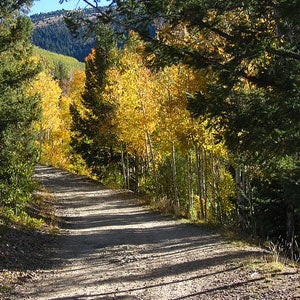
Photo of Aspen Vista trail by taylorandayumi/Flickr
The other weekend I ran a trail race for the first time since moving to New Mexico earlier this year. It didn't go well.
I'm not in good shape, which I blame on adopting a puppy who likes to chew my hands, hates sleeping, and has these namby-pamby “growth plates” that won't close for another year and mean he'll “get arthritis” if I take him running. (I predict a return to glory once he can train with me next summer. So, watch out.) Making matters somewhat worse, the course I ran started at 10,000 feet and climbed 5.8 miles to 12,000 feet, an elevation I've exceeded only one other time in my life, then returned to the start.
But what really debilitated me, I think, was my choice of shoes. I wore Merrell's Barefoot Trail Gloves, which are lightweight and un-cushioned and seemed perfect for a trail race. I've used the Trail Gloves for everything from easy runs to an ascent of a 14-er in southern Colorado. They're well-constructed and offer excellent traction.
The uphill half of the race went okay. It was hard, but I settled into a rhythm and tried to keep three of the runners ahead of me within sight, figuring I'd pass one or two of them on the downhill.
Until Saturday, I also figured I was a good downhill runner. It turns out that I'm not, at least if the trail is rocky. A half mile of high-speed shuffling into the downhill I was forced to slow down and eventually dropped five places by the finish. The low point came around mile eight, when a guy wearing and passed me like I was standing still. He, by contrast, appeared to be floating. Maybe a minute later, I stepped on a rock with my left foot and felt it dig nicely into my plantar fascia. My friend in the moon boots didn't look like his feet hurt at all, which made me angry because I knew how foolish he was to be wearing moon boots.
I've been a bit skeptical of shoes for a long time. The shoe industry hasn't made objectively positive changes in shoe technology since the 1970s, middle-of-the-road trainers now cost more than $100, and runners still suffer high rates of injury. (There's no evidence that running shoes prevent repetitive-stress injuries, and there's anecdotal evidence that they alter running form in less-than-good ways. I am, however, equally skeptical that barefoot running is a panacea.)
As a result, I've been inclined to dismiss shoe categories as marketing gimmicks, and since 2005 I've run in whatever has come to me for cheap or for free. I wear my shoes until they wear out, usually around 1,000 miles, and then retire them to my mother's house as a bulwark against her efforts to turn my old bedroom into an office.
After the race, I'm prepared to admit that purpose-built shoes are more valuable than I once believed. A well-cushioned shoe with hard rubber soles might not have let me descend much faster on Saturday—the guy who finished third wore a similar pair of minimal trail shoes from New Balance—but it would have made the descent less painful and more fun. Which is what's it's all about, right?
—Peter Vigneron
��